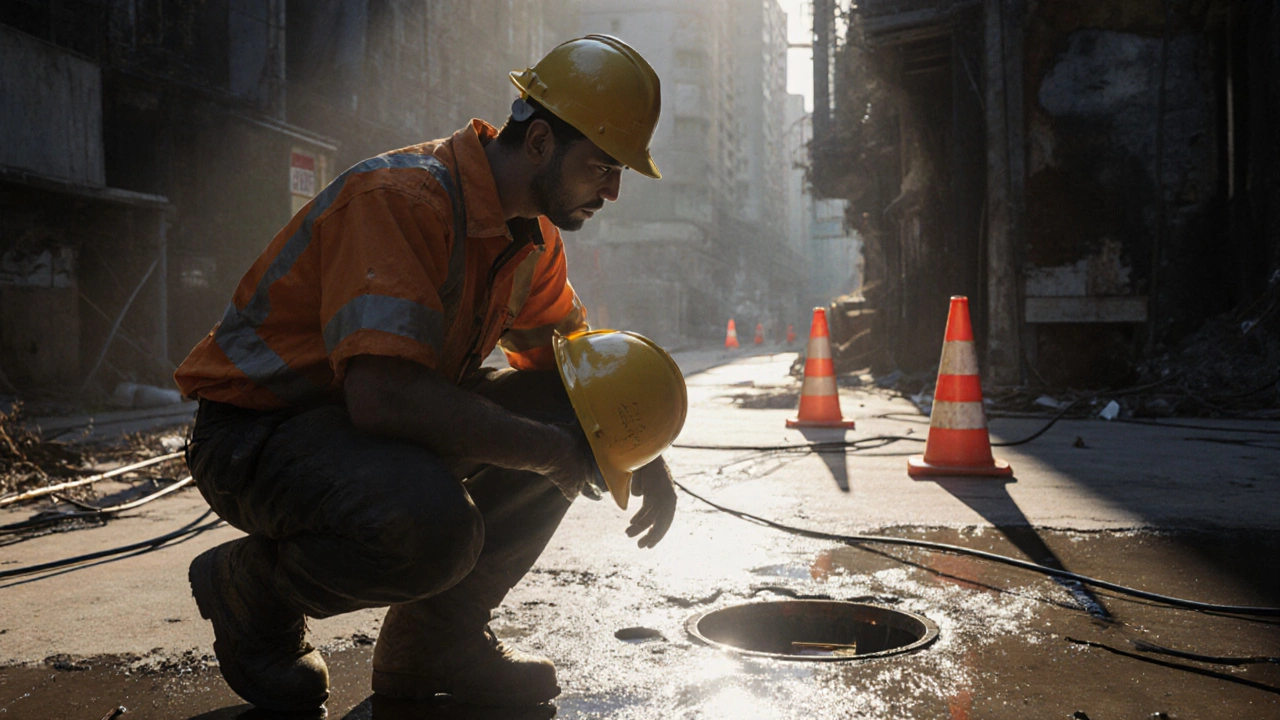Safety Habits Assessment Tool
How Safe Are Your Daily Habits?
Take this 7-question quiz to evaluate your workplace safety practices. Based on your answers, you'll receive personalized feedback on which steps you're mastering and where you can improve.
Your Safety Assessment
Every year, over 600,000 workers in the UK suffer work-related injuries or illnesses. Many of these could have been avoided with just a few simple actions. Safety isn’t about complicated rules or expensive gear-it’s about doing the right thing, every time. The 7 steps to safety are not a checklist you memorize for an exam. They’re the real, daily habits that keep people alive and well on the job.
1. See the Hazard Before You Start
You can’t fix what you don’t see. Before you even pick up a tool, look around. Is the floor wet? Are cables stretched across a walkway? Is a machine missing its guard? These aren’t minor issues-they’re triggers for accidents. In construction, a single unmarked hole caused 12% of serious falls in 2024, according to the Health and Safety Executive. Take five seconds. Scan your space. If something feels off, it probably is. Don’t wait for someone else to notice it. Your eyes are your first safety tool.
2. Stop and Think Before You Act
Speed kills. Not always in a crash, but in the quiet moments when you skip a step because you’re in a hurry. That time you didn’t lock out the power before cleaning a conveyor belt? That’s how a hand gets pulled in. That time you climbed on a wobbly crate instead of getting a ladder? That’s how a back gets ruined. The pause isn’t laziness-it’s control. Before you do anything risky, ask: "What’s the worst that could happen?" If the answer scares you, stop. Find a safer way. This habit alone cuts incident rates by nearly 40% in high-risk industries.
3. Use the Right Gear, Every Time
Hard hats, safety glasses, gloves, steel-toe boots-they’re not optional fashion statements. They’re your last line of defense. In 2023, 78% of eye injuries in manufacturing were from workers not wearing goggles. Not because they didn’t have them. Because they forgot. Or thought "just this once" was fine. Gear doesn’t work if it’s in your locker. Wear it. Keep it clean. Report broken equipment. If your helmet has a crack, don’t tape it. Replace it. Your body doesn’t get a second chance.
4. Follow the Procedure, Even When It’s Annoying
Procedures exist because someone got hurt doing it the "easy" way. The 3-step lockout/tagout process before servicing machinery? It takes longer. The double-check before lifting a heavy load? It slows you down. But skipping it? That’s how a spine gets crushed or a finger gets severed. In healthcare, skipping hand hygiene protocols led to 1 in 5 preventable infections in NHS facilities last year. Procedures aren’t bureaucracy-they’re survival blueprints. Do them. Even when no one’s watching.

5. Speak Up When Something’s Wrong
Too many people stay quiet. They think, "It’s not my job," or "They’ll think I’m complaining." But silence costs lives. If you see a frayed cord, a blocked exit, or a coworker lifting wrong-say something. Don’t wait for a safety meeting. Don’t write an email. Walk over. Say it out loud: "Hey, that’s not safe." Most workplaces that have strong safety cultures have one thing in common: workers feel safe speaking up. And managers listen. If you’re ignored, go higher. Your voice isn’t a nuisance. It’s a lifeline.
6. Clean Up After Yourself
Clutter is a silent killer. Boxes in the aisle. Oil on the floor. Tools left lying around. These aren’t just messy-they’re trip hazards, fire risks, and pinch points. In warehouses, unattended clutter caused over 2,300 injuries in 2024. Clean as you go. Put tools back. Wipe spills. Roll up cords. Make it someone else’s problem? No. Make it your responsibility. A tidy space isn’t about pride-it’s about preventing the next accident before it happens.
7. Report Everything, Even the Small Stuff
A small leak, a flickering light, a loose bolt-these seem trivial. But they’re early warnings. In aviation, 94% of major incidents were preceded by 10 or more small, unreported issues. The same applies in factories, offices, and care homes. If you see something odd, report it. Use the form. Tell your supervisor. Log it in the system. Don’t assume someone else will. If you don’t report it, the system can’t fix it. And if it doesn’t get fixed, someone will get hurt. Reporting isn’t tattling. It’s prevention in action.
Why These 7 Steps Work
These aren’t random tips. They’re based on decades of data from the Health and Safety Executive, OSHA, and real-world incident reviews. Companies that train workers on these exact steps see up to 60% fewer accidents in the first year. Why? Because they’re simple, repeatable, and human-centered. They don’t require degrees or expensive software. Just attention. Just care.
Safety isn’t a department. It’s a habit. It’s the person who checks the ladder before climbing. The one who calls out a shortcut. The one who picks up the spill. It’s not about being perfect. It’s about being consistent. One step at a time.
What Happens When You Skip Them
Take the story of a warehouse in Bristol. In 2024, a worker was seriously injured when a pallet fell on him. The investigation found he’d been told to stack higher than the safety limit. He didn’t speak up. The floor was wet from a leak no one reported. The forklift’s alarm was broken-reported three times, never fixed. The guard on the conveyor was missing. He’d been told to "just be careful." That’s not safety. That’s luck. And luck runs out.
How to Make These Steps Stick
Training alone doesn’t work. Posters don’t work. You need culture. Start small. At your next team huddle, ask: "What’s one thing we can do today to be safer?" Let people answer. Then act on it. Reward reporting, not just compliance. Celebrate the person who fixes a hazard before it hurts someone. Make safety part of your daily rhythm-not a monthly lecture.
Final Thought
Safety isn’t about rules. It’s about people. It’s the mother who comes home to her kids. The father who finishes his shift without pain. The colleague who shows up tomorrow, same as today. These seven steps are the quiet, ordinary actions that make that possible. You don’t need a medal for doing them. But you do need to do them. Every day. No exceptions.
Are these 7 steps required by law in the UK?
The exact wording of these seven steps isn’t written into law, but each one reflects legal duties under the Health and Safety at Work Act 1974. Employers must provide a safe workplace, and employees must take reasonable care of themselves and others. These steps are the practical way to meet those legal obligations. Skipping them means you’re not just taking risks-you’re breaking the law.
Can these steps be applied in offices, not just factories?
Absolutely. Office hazards include tripping over cables, ergonomic strain from poor chairs, electrical fires from overloaded sockets, and even stress from unmanaged workloads. Step 1-seeing the hazard-means noticing a loose carpet edge. Step 4-following procedure-means using the correct lifting technique when moving boxes. Step 5-speaking up-means telling your manager the fire exit is blocked. Safety isn’t about the job title. It’s about the situation.
What if my boss says safety slows us down?
Speed without safety isn’t efficiency-it’s a gamble. Studies show that for every £1 spent on safety training, businesses save £4 in reduced absenteeism, compensation, and downtime. One accident can shut down a site for weeks. One injury can cost thousands in legal fees and lost productivity. The slowest thing in the workplace isn’t following a procedure. It’s waiting for an accident to happen before you act.
Do I need formal training to follow these steps?
No. These steps are designed to be understood without training. But formal training helps you recognize hazards you might miss, understand legal rights, and learn how to report properly. If your workplace offers safety training, take it. But even without it, these seven steps are enough to keep you and others safe. Knowledge isn’t a certificate. It’s what you do when no one’s looking.
How do I get my team to take these steps seriously?
Lead by example. If you’re the first to wear your PPE, clean up after yourself, and speak up about hazards, others will follow. Don’t shame people for mistakes. Celebrate safe behavior. Make safety part of your daily chat-not just a quarterly meeting. Ask, "What’s one thing we did well today to stay safe?" Small recognition builds lasting habits. Culture changes one action at a time.





Write a comment